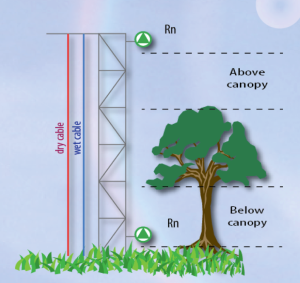Evaporation measurements with fibre optic temperature sensing (DTS)

Setup DTS to measure evaporation.
The distributed temperature sensing (DTS) technique provides high-resolution temperature data along a fibre optic cable, by sending a laser pulse through the cable and analysing the back-scattered signal that is altered by temperature differences along the cable. The technology already exists for a long time, but its value for hydrology has just recently been acknowledged and currently more and more applications are showing up. Also the potential for measuring evaporation with DTS is promising. Short duration experiments in South Africa (corn field) and in a pine forest in The Netherlands have shown good agreement with eddy correlation systems and scintillometers.
To measure evaporation with DTS, the Bowen ratio method is used, whereby temperature and vapour pressure profiles are measured along with net available energy. The classical Bowen ratio method, whereby the gradient is determined at only two elevations with separated sensors, is often seen as an inaccurate method due to the high impact of measuring errors in the determination of the gradient. However, with DTS, continuous temperature gradients can be accurately measured with a single sensor (a vertically installed cable has a dry and a wet stretch), resulting in much smaller measurement errors. To measure vapour pressure with DTS, we wet the cable to get the so-called ‘wet bulb’ temperature, from which the vapour pressure can be derived through the psychrometer principle. Combining the temperature profiles of the dry and wet cables, makes DTS an excellent new method to derive actual evaporation.
Example of dry and wet bulb temperature observations (courtesy Bart Schilperoort).
Papers on this topic:
Schilperoort, B., Jiménez Rodríguez, C., van de Wiel, B., and Coenders-Gerrits, M.: A distributed-temperature-sensing-based soil temperature profiler, Geosci. Instrum. Method. Data Syst., 13, 85–95, https://doi.org/10.5194/gi-13-85-2024, 2024.
Zimba, H., Coenders-Gerrits, M., Banda, K., Schilperoort, B., van de Giesen, N., Nyambe, I., and Savenije, H. H. G.: Phenophase-based comparison of field observations to satellite-based actual evaporation estimates of a natural woodland: miombo woodland, southern Africa, Hydrol. Earth Syst. Sci., 27, 1695–1722, https://doi.org/10.5194/hess-27-1695-2023, 2023
Bart Schilperoort; Miriam Coenders-Gerrits; César Jiménez Rodríguez; Antoon van Hooft; Bas van de Wiel; Hubert Savenije: Detecting nighttime inversions in the interior of a Douglas fir canopy, Agricultural and Forest Meteorology, https://doi.org/10.1016/j.agrformet.2022.108960, 2022
Schilperoort, B., Coenders-Gerrits, M., Jiménez Rodríguez, C., van der Tol, C., van de Wiel, B., and Savenije, H.: Decoupling of a Douglas fir canopy: a look into the subcanopy with continuous vertical temperature profiles, Biogeosciences, 17, 6423–6439, https://doi.org/10.5194/bg-17-6423-2020, 2020.
van Ramshorst, J. G. V., Coenders-Gerrits, M., Schilperoort, B., van de Wiel, B. J. H., Izett, J. G., Selker, J. S., Higgins, C. W., Savenije, H. H. G., and van de Giesen, N. C.: Revisiting wind speed measurements using actively heated fiber optics: a wind tunnel study, Atmos. Meas. Tech., 13, 5423–5439, https://doi.org/10.5194/amt-13-5423-2020, 2020.
Jonathan G. Izett, Bart Schilperoort, Miriam Coenders-Gerrits, Peter Baas,
Fred C. Bosveld, Bas J. H. van de Wiel (2019): Missed fog? On the potential of obtaining observations at increased resolution during shallow fog events. Boundary-Layer Meteorology. https://doi.org/10.1007/s10546-019-00462-3
Bart Schilperoort, Miriam Coenders-Gerrits, Willem Luxemburg, César Jiménez Rodríguez, César Cisneros Vaca, and Hubert Savenije (2018): Technical note: using Distributed Temperature Sensing for Bowen ratio evaporation measurements. Hydrology and Earth System Sciences, 22. 819-830 + data
Euser, T., Luxemburg, W. M. J., Everson, C. S., Mengistu, M. G., Clulow, A. D., and Bastiaanssen, W. G. M.: A new method to measure Bowen ratios using high-resolution vertical dry and wet bulb temperature profiles, Hydrol. Earth Syst. Sci., 18, 2021-2032, https://doi.org/10.5194/hess-18-2021-2014, 2014.

Pingback: Evaporation: the invisible water drain